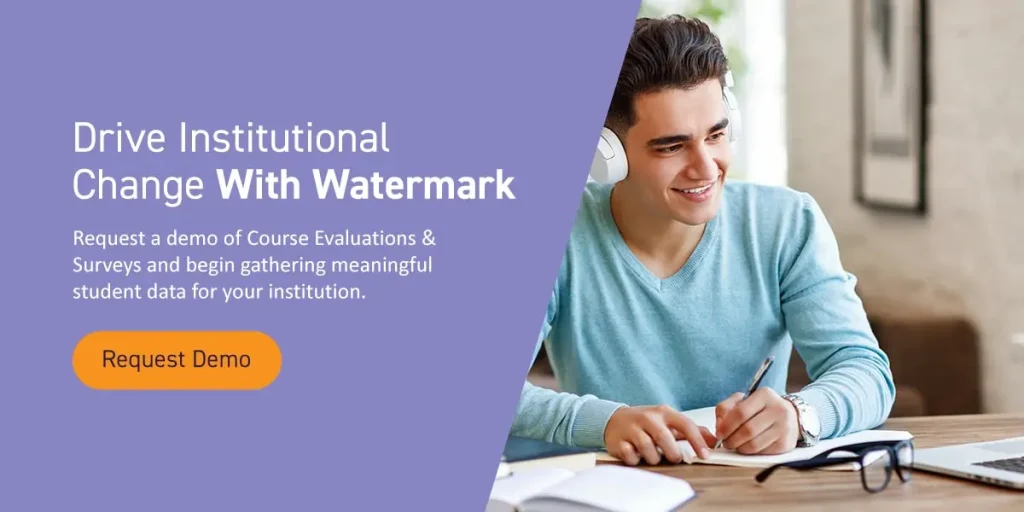




Understanding the role of assessment in instruction is critical to discovering valuable information that can impact and improve your higher education institution. Meaningful assessments reveal useful details about student experiences, teaching practices, campus culture and community, and more. By reflecting on this information, you can discover where your institution is lacking and where it is excelling.
The term “assessment” has expanded to mean more than standardized exams and performance tests. Assessments measure what students can do, what they know, and how it impacts the institution. Colleges and universities use this information to discover group patterns and understand how students learn.
Assessment professionals have taken the lead in providing evidence of student learning. They typically work in full-time positions for higher education institutions. They may be administrators or other faculty with job titles such as assessment specialist, director of assessment, or assessment coordinator. Assessment professionals focus most of their functions on programs and institutions, including grants, student learning, accreditation, planning, institutional effectiveness, and academic program review.
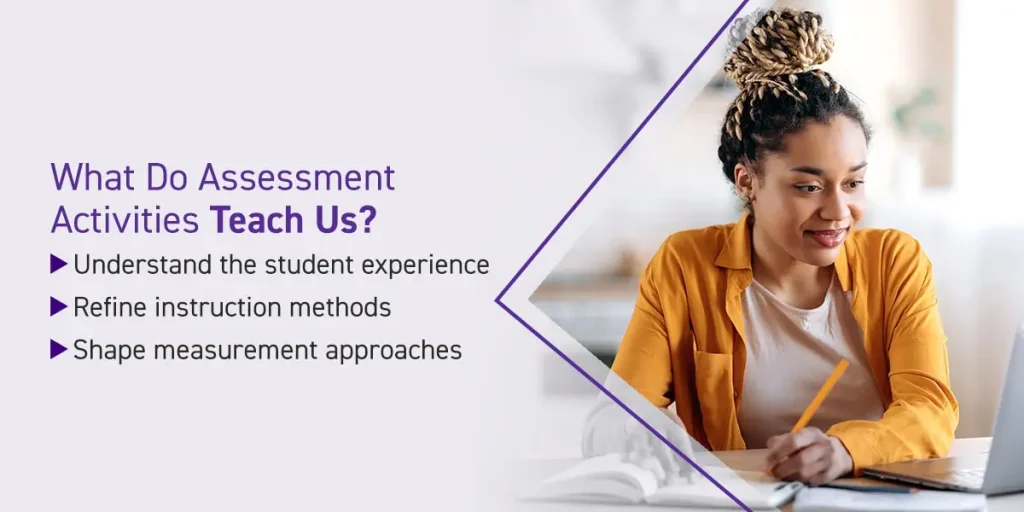
Well-done assessment activities contribute to improving and understanding student success and learning. They uncover deficiencies and identify strengths in educational models. Institutions can use this data to enhance students’ relationships and their studies. Practitioners in assessment positions can use these activities to help their institution:
Assessment activities do more than show direct student results from class instruction. Though those statistics play a significant role in setting campus initiatives, they are only part of the equation. Comprehensive assessments take a deep dive into an institution to show the effectiveness of teaching practices, highlight student comprehension, acknowledge pain points, and ultimately create a more rewarding experience.
Consider these benefits of using assessment for professional standards.
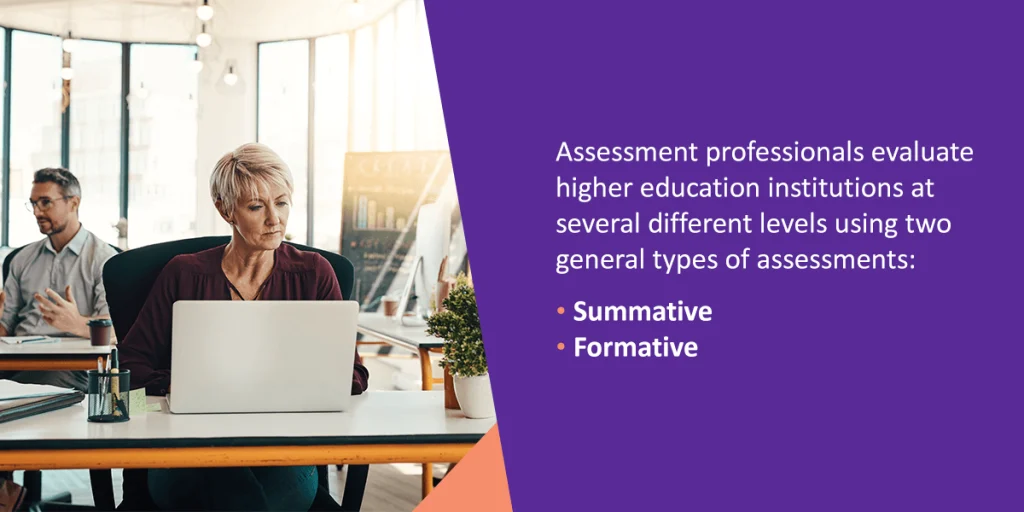
Assessment professionals evaluate higher education institutions at several different levels using two general types of assessments:
Assessing student progress throughout their time at the institution helps stakeholders get a general idea of how well students achieve the key learning objectives of each program. Typically, assessment professionals evaluate student performance at two levels:
At this level, assessment professionals use both formative and summative assessments to evaluate whether individual courses:
A program assessment involves evaluating how well each course contributes to the expected learning outcomes for the whole course of study. Important considerations at this level include:
Summative program assessments also enable stakeholders to determine how well each academic program advances the institution’s goals as a whole.
Assessment professionals examine how well an institution prepares its students for success after graduation. This high-level overview helps establish new processes that will position the school for continuous improvement.
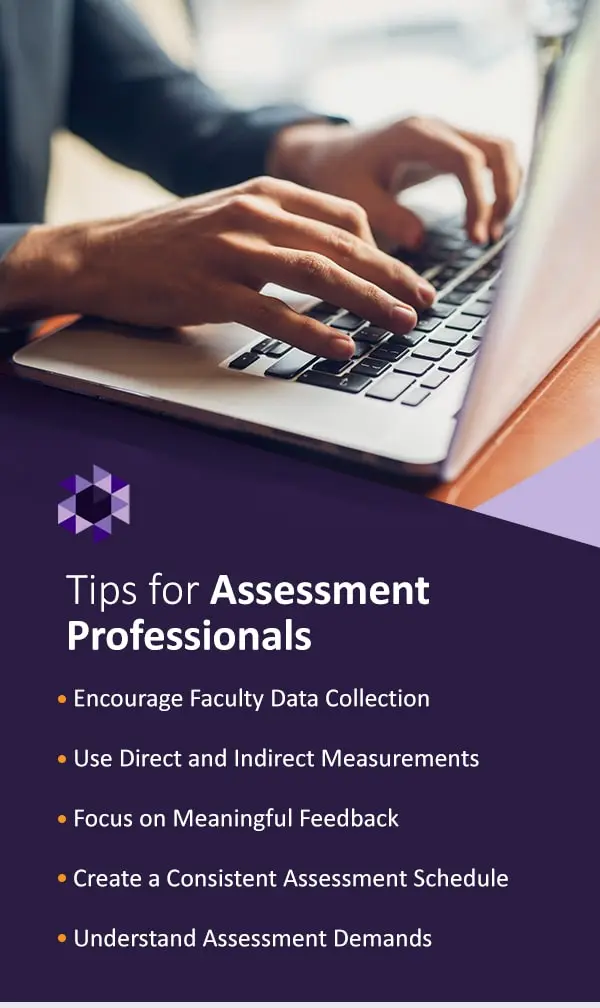
Preparing, crafting, conducting, and reviewing meaningful assessments can be challenging for some. Assessment professionals who are solely responsible for these tasks may lose valuable information in oversight. Review these tips to make the process more efficient as you prepare to gather new assessment data.
Make sure your staff takes action to collect data. Neglecting to collect and review data can result in losing opportunities regarding decision-making, educational planning, student learning, and resource allocation. When only a fraction of your staff and faculty understand the importance of data collection and review, you may experience resistance, making change difficult. Provide training sessions, workshops, or other development opportunities to ensure your staff understands assessment competence.
Teachers should look for opportunities to encourage students to self-reflect and review course and instructor evaluations in the classroom. Doing so will enable students to form deeper connections with their studies while helping educators become aware of student concerns. Without feedback, instructors cannot effectively work to improve their curricula. Once instructors are aware of the pain points in their teaching methods, they can start addressing them.
Comprehensive assessments will use indirect and direct strategies to measure student learning. You should ensure your institution uses both metrics to create an all-encompassing image of your institution and student success. They are vital to the data collection process and will enable you to make decisions that address concerns while combating academic obstacles.
Direct measurement will provide tangible, quantitative proof of student learning, such as projects, essays, and exams. Over time, you can reflect on these to track trends and gain insight into what students can do and how much they know.
Indirect measurements supplement direct measurements by assessing thoughts or opinions regarding student skills and knowledge. Examples include success indicators such as graduation rates, course evaluations, self-reported surveys, and job replacement rates. Indirect measurements encourage students, faculty members, and graduates to vocalize their opinions on program success, course effectiveness, and the entire institution.
Each assessment should have a clear purpose, and questions should reflect the information you want to obtain. For example, if a survey aims to evaluate an instructor’s teaching effectiveness, questions about campus culture or dorm buildings would not be relevant. Though those questions may be perfect for an assessment regarding campus community, they will not help you discover new information about educators.
Additionally, you should continue using the same questions over time to gauge any positive or negative changes. You can use the surveys from multiple semesters to determine if students are responding positively to the changes your instructors are making in the classroom. Keeping the questions consistent will enable you to make direct comparisons.
Creating an assessment schedule benefits your institution and those answering the questions. You can stay organized when you have a consistent schedule and prepare your students and faculty for assessment administration. Consider administering your assessments around the same time at the end of every semester. That way, students will have ample time to form opinions about their courses, and educators will have opportunities to reconsider their teaching methods.
Additionally, regularly administering assessments lets your students know you care about them and their experiences. By consistently asking what your institution can do to provide the best educational journey, your students may realize they can have a hand in shaping their futures with academic professionals who want to see them succeed.
Creating digital assessments for courses and instructors increases the likelihood that more students will respond. When students can provide feedback on their time and feel confident that their identity will remain anonymous, they may be more likely to give more thoughtful and accurate answers.
The form of each assessment requires students and faculty to respond accordingly. Some assessment forms demand little preparation, while others are much more time-consuming. When constructing an assessment, you must understand these demands.
Timed assessments, such as exams and tests, require students to showcase their knowledge. Though some students may naturally excel at retaining information, others will resort to last-minute cramming or spending hours to ensure comprehension. While these assessments act as direct measurements for institutions, they are not the sole indicators of success.
Self-assessments encourage students to develop judgment about their abilities and knowledge. Institutions can foster a sense of ownership and responsibility by encouraging students to evaluate their work and decide whether they performed their best or could have done better. Initially, many students may resist self-assessment attempts because they lack confidence in their skills. However, they can gain a more profound understanding of what they do well over time. Students may compile portfolios, learner diaries, reflection logs, and more.
Course evaluations and instructor surveys likely require the least time and effort for students to complete. Although these assessments can provide much information regarding classroom and institution strengths and weaknesses, not every student will answer accurately. Some students may complete the minimum to turn in the evaluation, while others may neglect it entirely. Institutions should shape these assessments to make them more desirable for students. That could mean limiting the number of questions, making the evaluation virtually available, giving participants time in class to complete the questions, or another method of engaging students.
Institutional assessments are about more than simply gathering data — you need to demonstrate why this data matters to your most important stakeholders.
Here are some tips for presenting assessment outcomes:
Now that you know how to create meaningful assessments and why they’re beneficial, you must also consider how you plan to use them to improve your institution. The information you’ve gathered won’t be valuable unless you know how to inspire change with the results. You can use your data to create new goals, set your sights on improving institution initiatives, and create a more enriching student experience.
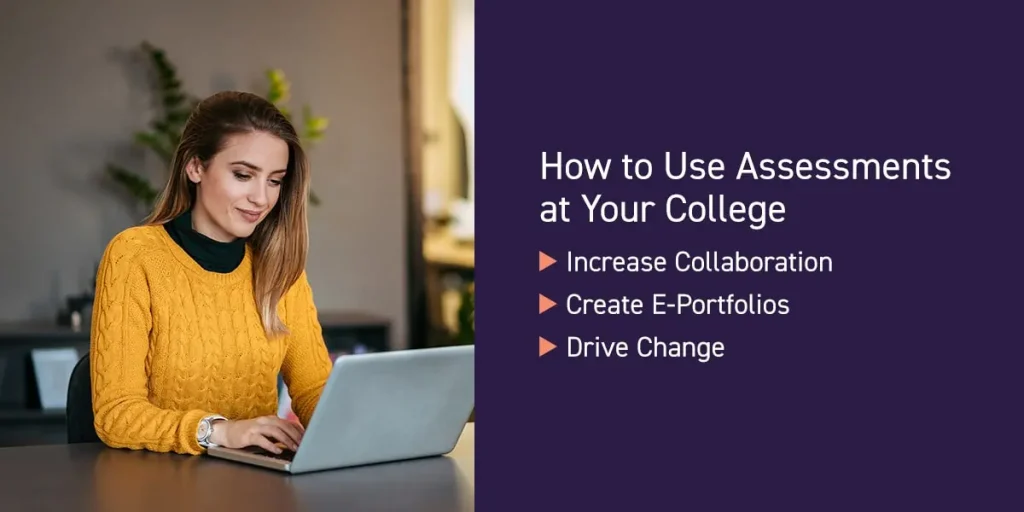
Assessments are excellent places to open the floor for institution-wide collaboration. As staff and faculty discuss their findings, they can work to develop unique answers. Each staff member will bring a unique perspective to the conversation, and as ideas bounce around, you may realize it’s much easier to find a practical solution when your staff is working together.
An increase in cooperation may make it easier to implement departmental changes. As instructors transition from one teaching model to another, they can reflect on outcomes with colleagues to discuss which practices are working and which are not. As more people become aware of the pain points and reflect on possible solutions, the quicker it will be to develop a model that maximizes student retention and engagement.
You can encourage students to complete self-assessments by creating ePortfolios. These end-of-semester assessments encourage students to link their educational experiences with their goals, interests, and career plans. They represent an effective way to create a self-assessment and ensure students have something tangible to show prospective employers. Through ePortfolios, students can demonstrate how much work they’ve put into their studies, where they’ve excelled, and what they’ve learned.
Additionally, ePortfolios are an effective way to measure student engagement with a course. Instructors can evaluate which activities students found more meaningful, what assignments they enjoyed, and how well students think they did when completing a task.
Ultimately, you want to use your data to drive change and make improvements at your institution. The goal is to create enriching environments and encourage students to complete their studies. If you use what you’ve learned to improve your campus, you’re on the right path.
Change at your institution may involve the following:
Assessments provide concrete evidence of your institution’s ability to benefit your students, which is vital for securing funding and retaining students. When your stakeholders — including students, parents, administrators, trustees, and donors — see how committed your institution is to student growth and success, they’ll be more likely to engage fully with you. Increased engagement can help encourage you to push your limits and grow even more.
Watermark has spent the last 20 years helping higher education institutions collect data and learn from it. Our experience has enabled us to craft innovative solutions that empower colleges and universities to discover and support meaningful practices.
Watermark Course Evaluations & Surveys allows you to quickly capture and analyze student feedback so you can find solutions faster. Our software will translate responses into actionable insights to improve learning and teaching outcomes. You can automatically distribute data to instructors, administrators, and teaching assistants to keep your entire staff in the know.
Our software seamlessly integrates with many student information systems, so your institution can build on your existing technology. You can boost student response rates to make completing evaluations, surveys, and other assessments as easy as possible. With more students completing the assessment, you can gather extra feedback to improve your institution.
Request a demo of Course Evaluations & Surveys and begin gathering meaningful student data for your institution. We’ve made collecting and reviewing your information easy so you can start setting new goals as quickly as possible.
